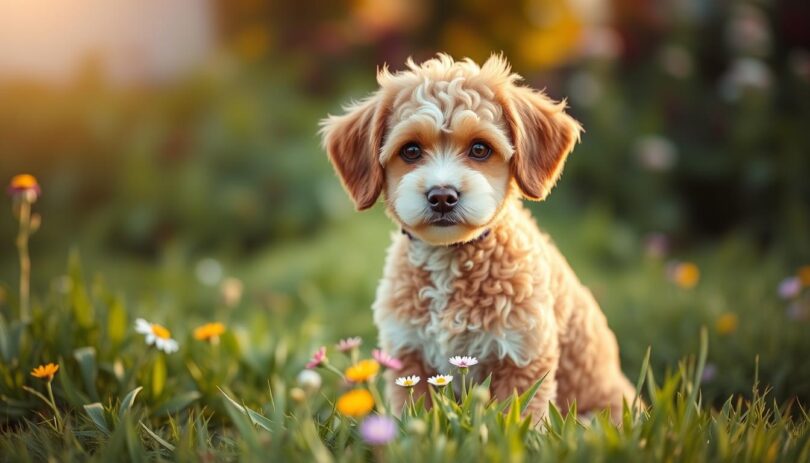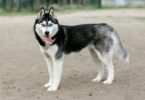What happens when you blend the playful energy of a scent hound with the sharp intelligence of a curly-coated companion? This unique mixed breed—often called a “designer dog”—combines two beloved breeds into one affectionate, adaptable pet. Whether you’re a first-time owner or a seasoned dog lover, understanding this hybrid’s quirks and qualities is key to building a happy life together.
Born from the union of Beagles and Poodles, these dogs inherit traits from both parents. Expect a lively personality paired with hypoallergenic fur—a perfect match for active families. Their loyalty and curiosity make them quick learners, though their hunting instincts might lead to the occasional backyard adventure.
This guide covers everything from grooming needs to training strategies. You’ll discover how to manage their diet, address common health concerns, and nurture their social nature. Ready to unlock the secrets of raising a well-adjusted companion? Let’s explore what makes this mixed breed so special.
Introduction to the Beagle Poodle Mix
A perfect blend of brains and loyalty defines this popular designer breed. Combining the sharp wit of the Poodle parent with the affectionate nature of its Beagle lineage, these hybrids thrive in homes craving both companionship and adventure. Their adaptable personality suits urban apartments and suburban yards alike, making them a rising favorite among U.S. families.
What Makes This Hybrid Unique?
These dogs inherit a striking mix of traits from both parent breeds. The Poodle’s hypoallergenic coat often blends with the Beagle’s signature markings, creating pups with low-shedding fur in diverse colors. Their intelligence shines during training sessions, though their playful stubbornness might test your patience when they catch an interesting scent.
An Overview for New Dog Parents
First-time owners will appreciate their social nature and moderate energy levels. Daily walks and puzzle toys keep them mentally stimulated, while consistent routines help manage their occasional independence. Families with kids or other pets find their gentle demeanor and curiosity ideal for active households.
Upcoming sections will explore their history, grooming needs, and training methods to help you build a thriving relationship. Whether you’re drawn to their loyalty or adaptable size, this breed offers a rewarding experience for dedicated owners.
The Breed’s History and Origins
How did two distinct hunting breeds merge into today’s beloved companion? The answer lies in centuries of specialized breeding. Each parent brings a legacy shaped by their original roles, creating a hybrid with surprising versatility.
Tracing the Poodle and Beagle Heritage
Poodles began as water retrievers in Germany, prized for their intelligence and athleticism. Nobility later favored them as loyal companions. Their curly, hypoallergenic coat evolved to protect them during aquatic hunts.
Beagles trace back to 16th-century England as scent-driven hunting dogs. Their compact size and persistence made them ideal for tracking rabbits. Unlike Poodles, they thrived in packs, fostering their social nature.
When combined, these dog breeds produce offspring with keen noses and problem-solving skills. The hybrid often inherits the Poodle’s low-shedding fur and the Beagle’s vocal curiosity. However, no official breed standard exists since traits vary widely between litters.
Genetic diversity leads to unpredictable appearances and temperaments. Some pups lean toward one parent’s traits, while others blend both. This variability affects pricing, with responsibly bred hybrids often costing more due to health testing and lineage verification.
Physical Appearance and Personality Traits
From their coats to their quirks, these hybrids showcase a fascinating blend of features. No two dogs look or act exactly alike, making each one a unique companion. Their appearance and behavior depend heavily on which parent’s genes dominate—a genetic lottery that keeps owners guessing.
Variations in Coat, Size, and Colors
Coat textures range from tight curls to short, sleek fur. Some inherit the hypoallergenic curls of their Poodle lineage, while others sport the Beagle’s smooth, easy-care coat. Colors span tri-color patterns, solid creams, or rich chocolates.
Size variations depend on the parents. Smaller hybrids weigh 15–25 pounds, standing 12–15 inches tall. Larger ones may reach 30 pounds with longer legs. This unpredictability means you’ll want to meet both parent dogs before adoption.
Understanding Temperament and Energy Levels
Temperament swings between playful mischief and calm cuddles. Some dogs inherit high energy and need vigorous daily exercise. Others lean toward relaxed lounging but still enjoy interactive games.
Environment shapes their personality too. Busy households often see more outgoing traits, while quieter homes may foster a mellow companion. Regular walks and scent-based toys help balance their energy.
Prospective owners should embrace this variability. Whether your pup becomes a chatty explorer or a thoughtful observer, their adaptability makes them a delightful fit for diverse lifestyles.
Essential Traits of the beagle poodle mix
Owners of this spirited hybrid quickly discover a blend of qualities that demand attention and reward patience. Their dual heritage creates a puzzle of instincts—part detective, part scholar—requiring thoughtful guidance to thrive.
Key Characteristics to Expect
Loyalty defines these dogs. They form deep bonds with families but may shadow household members during daily routines. Intelligence shines through problem-solving skills, though curiosity can lead to mischief if left unchanneled.
Balancing physical activity with mental stimulation proves critical. A 30-minute walk paired with scent games satisfies their need for exploration. Puzzle toys or obedience drills prevent boredom-induced behaviors like chewing or digging.
Playfulness often masks independence. These dogs enjoy interactive fetch sessions but might ignore commands when tracking intriguing smells. Consistency in training helps bridge their eager-to-please nature and stubborn streaks.
Successful owners adapt strategies to their dog’s unique mix of traits. Early socialization and varied routines harness their potential, creating companions equally ready for adventures or cozy evenings. Understanding this balance transforms challenges into opportunities for connection.
Grooming and Coat Care Tips
Maintaining a healthy coat requires understanding your dog’s unique genetic blueprint. Their fur type—whether curly like one parent or short like the other—determines your grooming game plan. A tailored approach prevents tangles, reduces allergens, and keeps their skin irritation-free.
Choosing the Right Brushing Routine
Start by identifying their dominant coat type. Curly-haired hybrids need slicker brushes to detangle tight curls without pulling. Short-coated pups benefit from rubber grooming gloves that remove loose hair during cuddle sessions.
Plan brushing sessions weekly to maintain coat health. This rhythm prevents mats in curly fur and minimizes shedding in smoother varieties. For dogs with mixed textures, alternate brush types based on problem areas like behind the ears or along the belly.
Managing Different Coat Types
Curly coats demand professional trimming every 6–8 weeks to avoid painful knots. Use leave-in conditioners between salon visits to keep curls springy. Short-haired dogs thrive with monthly baths and occasional de-shedding tools during seasonal changes.
Consistent grooming does more than enhance appearance—it strengthens your bond. Regular checkups during brushing help spot skin issues early. Pair these sessions with treats to create positive associations, turning maintenance into moments of connection.
Health Considerations and Preventative Care
Keeping your hybrid healthy starts with understanding their unique genetic risks. While generally robust, this designer breed may inherit vulnerabilities from both parent lines. Proactive care and early detection help prevent minor health issues from becoming major concerns.
Common Issues to Monitor
Hip dysplasia ranks among the top health problems in poogles. This joint condition occurs when the hip socket doesn’t fully support the thigh bone, potentially causing pain and reduced mobility. Regular vet screenings can catch early signs like stiffness after exercise.
Eye conditions also demand attention. Some poogles develop glaucoma or progressive retinal atrophy, inherited from their Poodle ancestry. Watch for cloudiness, excessive blinking, or bumping into furniture—subtle clues worth discussing with your veterinarian.
Building a Prevention Strategy
Maintain a healthy weight through portion control and low-impact exercises like swimming. Excess pounds strain joints, worsening dysplasia symptoms. Schedule biannual checkups to assess joint health and vision clarity.
Create a symptom journal noting changes in activity levels or grooming habits. Early intervention often leads to better outcomes. Pair these efforts with pet insurance tailored to hereditary conditions—many plans now cover breed-specific health issues.
Remember: Your poogle’s mixed heritage doesn’t guarantee problems, but informed vigilance lets them thrive. Simple steps like paw checks after walks and odor-free ear cleanings become powerful tools in your preventative care toolkit.
Dietary Needs and Feeding Guidelines
Fueling your companion’s adventures starts with smart nutrition choices. These hybrids thrive on balanced meals that support their active lifestyles while preventing weight gain—a common concern given their hearty appetites. Prioritize quality ingredients tailored to their energy demands and coat health.
High-Quality Foods for Optimal Health
Choose kibble with animal protein as the first ingredient, avoiding fillers like corn or soy. Many owners supplement dry food with fresh additions: steamed carrots, lean turkey, or omega-3-rich salmon. These nutrients boost skin health and maintain that signature glossy coat.
Portion sizes depend on activity levels. A 20-pound hybrid might need 1½ cups daily, split into two meals. Use a measuring cup—eyeballing amounts often leads to overfeeding. Treats should never exceed 10% of their daily calories to avoid obesity risks.
Watch for signs of food sensitivities, particularly if your pet scratches excessively or has digestive issues. Rotate proteins every few months under veterinary guidance to identify allergies early. Always provide fresh water, especially after play sessions.
Regular weight checks help adjust feeding plans as needed. Pair proper nutrition with exercise routines for a vibrant, healthy companion ready for every tail-wagging challenge.
Exercise and Mental Stimulation Requirements
Meeting your dog’s physical and cognitive needs requires strategic planning. Inheriting traits from scent-driven and problem-solving ancestors, these hybrids demand structured routines to channel their energy productively. Without proper outlets, their natural curiosity may turn toward chewing furniture or digging up gardens.
Daily Walks and Playtime Essentials
Two 30–45 minute walks daily form the foundation of their exercise regimen. Vary routes to engage their powerful sense of smell—let them sniff fire hydrants or track hidden treats during walks. Off-leash play in secure areas allows full-speed sprints to burn excess energy.
Interactive games like flirt pole chasing or water retrieves tap into their hunting instincts. Rotate activities weekly to prevent boredom. A tired dog is a well-behaved dog, making consistency non-negotiable for managing their stamina.
Interactive Toys and Training Games
Puzzle feeders that dispense kibble when solved keep minds sharp during downtime. Try hiding treats in snuffle mats or frozen Kongs to mimic foraging challenges. Short training sessions teaching “find it” commands or agility courses strengthen both focus and physical coordination.
Combine mental stimulation with exercise through scent work. Hide toys in your yard and reward successful discoveries. These activities satisfy their need to problem-solve while reinforcing obedience skills.
Balance is key: alternate fetch sessions with nosework games to engage body and mind equally. Structured routines prevent restlessness while deepening your bond through shared accomplishments.
Training Strategies for a Well-Behaved Companion
Crafting a well-mannered companion starts with understanding their curious mind and love for rewards. These hybrids excel when training sessions feel like games, blending mental challenges with tasty incentives. Owners who master this balance unlock their dog’s full potential while strengthening trust.
Establishing Obedience and Focus
Begin with 5–10 minute sessions twice daily to match their attention span. Use high-value treats like freeze-dried liver to reinforce commands like “sit” or “stay.” Gradually increase distractions—practice near open windows or during mild outdoor activity.
Focus-building games work wonders. Hold a treat in your closed fist until they stop pawing and make eye contact. Reward calm behavior immediately. This teaches impulse control and strengthens your leadership role.
Overcoming Stubbornness with Positive Reinforcement
When they ignore commands during scent exploration, avoid scolding. Instead, use a cheerful voice to redirect their attention. Toss a treat away from the distraction while saying “leave it,” then praise compliance enthusiastically.
Consistency trumps intensity. If they jump during greetings, turn away until paws touch the floor. Reward four-on-the-floor positions every time. Within weeks, this shapes polite greeting habits without confrontation.
Socialization Techniques for Early Success
Expose puppies to varied environments before 16 weeks. Schedule weekly “field trips” to pet-friendly stores, parks, and sidewalks. Pair new experiences with treats to build positive associations.
Arrange controlled playdates with vaccinated dogs. Watch for relaxed body language—play bows and loose tails indicate they’re learning to get along. Interrupt rough play gently, offering chew toys as alternative outlets.
Celebrate small victories. A dog that sits calmly when guests arrive or walks politely past squirrels demonstrates training success. Adjust methods as they mature—what works at 6 months might need tweaking by age two.
Early Life and Puppy Development
The first 18 months shape a dog’s future behavior and adaptability. Puppies experience rapid physical and emotional changes during this period, requiring intentional guidance to thrive. Early exposure to diverse experiences builds resilience, while consistent routines create security.
Navigating Growth Phases
From 8 weeks to 6 months, puppies absorb information like sponges. This critical window demands daily socialization with children, strangers, and household noises. Positive interactions during vet visits or car rides reduce fear responses later.
Adolescence (6–18 months) brings testing boundaries. Energy spikes and selective hearing emerge as hormones shift. Maintain structured meal times and walk schedules each day to reinforce stability. Celebrate milestones like loose-leash walking or calm greetings as signs of maturity.
Children play a vital role in teaching gentle handling. Supervised playdates help pups learn bite inhibition and respect personal space. Pair these sessions with crate training to establish quiet time expectations.
Transitioning to adulthood requires gradual responsibility shifts. Replace puppy pads with outdoor potty breaks, and introduce longer walks. Consistency in rules—like no sofa access—helps them understand evolving household roles. Patience during this phase builds trust that lasts a lifetime.
Socialization Tips for Families and Other Pets
How do you help a curious pup become a confident family member? Early socialization shapes their ability to interact safely with children and coexist peacefully with other animals. Starting this process during puppyhood builds lifelong habits while managing their natural hunting instincts.
Child-Friendly Interaction Strategies
Teach kids to approach calmly, offering treats with open palms. Supervise play to prevent tail-pulling or sudden movements that might trigger defensive reactions. Reward gentle behavior with praise when the dog sits politely during family activities.
Introduce small animals gradually using scent exchanges first. Let them sniff a blanket used by the other pet before face-to-face meetings. Always keep dogs leashed during initial interactions with rabbits or guinea pigs to curb chase impulses.
Multi-Pet Household Success
Arrange neutral-space introductions for dogs meeting cats or other pets. Walk both animals parallel to each other at a distance before allowing direct contact. Watch for relaxed body language: loose tails and soft eyes signal readiness for closer interaction.
Create positive associations by feeding pets on opposite sides of a baby gate. This builds tolerance while preventing food-guarding incidents. Consistent routines help establish peaceful coexistence in busy households.
Living Environments: Apartment and Home Adaptations
Urban dwellers and suburban homeowners alike often wonder if their space suits a lively companion. This adaptable breed thrives in both settings when owners address their need for activity and mental engagement. Small homes work well with creative planning, while houses with yards benefit from structured play zones.
Daily exercise remains non-negotiable regardless of square footage. Two brisk walks totaling 60 minutes meet basic needs, but brain games prevent restlessness. Try hiding treats in folded towels or rotating puzzle toys weekly to challenge their problem-solving skills.
Compact living spaces demand smart modifications. Secure loose wires and elevate fragile items to counter curious noses. Designate a digging-approved area with a sandbox or shredded paper bin to protect carpets. Window perches let them observe outdoor action safely.
Indoor fetch sessions using soft toys burn energy during rainy days. Staircase races or tug-of-war games offer quick cardio bursts. Pair these with obedience drills to reinforce commands while tiring them out.
Outdoor time proves essential even for city dogs. Seek parks with varied terrain for sniffing adventures. Weekend hikes or swimming trips provide novel experiences that satisfy their exploratory nature. Consistent care ensures contentment in any home setup.
Insider Tips for New Poodle Parents
Preparing for a new furry family member begins with smart choices before they ever enter your home. Whether adopting or working with a breeder, understanding ethical practices ensures your pet’s health and happiness. These strategies help create a smooth transition while honoring the unique needs of this hybrid.
Choosing Ethical Breeders and Rescue Options
Always verify kennel club affiliations when selecting breeders. Responsible providers share health clearances for both parent breeds, including hip evaluations and eye tests. Ask to meet the puppy’s parents—observing their temperament offers clues about your future companion’s behavior.
Rescue organizations often have adult poogles needing homes. These pets may already know basic commands, saving time on early training. Check shelters affiliated with national breed clubs for vetted adoption processes.
Preparing Your Home for a New Arrival
Puppy-proof spaces by securing trash cans and electrical cords. Designate a quiet area with chew toys and a crate lined with washable bedding. Stock up on grooming tools suited to your pet’s coat type—slicker brushes for curls or de-shedding gloves for smoother fur.
Start socialization during the first week. Introduce household sounds like vacuums and doorbells using positive reinforcement. Blend mental stimulation with physical activity through treat-dispensing toys that challenge their problem-solving skills inherited from parent breeds.
Remember: Early routines shape lifelong habits. Schedule vet visits within 48 hours of bringing your poogle home to establish baseline health metrics. Consistent care during these formative weeks builds trust and adaptability in your growing companion.
Final Reflections on Welcoming Your New Companion
Bringing home a lively companion shaped by two distinct dog breeds is both thrilling and responsibility-rich. These hybrids thrive when families balance their spirited energy with structured routines, blending playfulness with purpose. Their adaptability shines in diverse homes, whether buzzing with kids or quiet with retirees—provided their exercise and mental needs stay prioritized.
Remember: consistency in training and early socialization helps them get along with other pets. Regular vet checkups address potential health issues inherited from parent breeds, while proper coat care keeps allergies at bay. For those exploring similar crossbreeds, our guide to other designer dogs offers valuable comparisons.
Every poogle carves its own path, mixing loyalty with curiosity. Celebrate their quirks—whether tail-wagging greetings or determined sniffing sessions. With patience and informed care, you’ll unlock a bond that grows stronger through shared adventures and cozy evenings alike.
Your commitment shapes their world. Embrace the journey, and let this clever companion remind you daily why mixed breeds capture hearts so completely.
FAQ
Are Poogles suitable for families with young children?
Yes! These hybrids typically inherit a playful, patient temperament from their parent breeds. Early socialization helps them bond well with kids. Always supervise interactions with toddlers to ensure gentle play.
How often should I groom a Beagle-Poodle cross?
Brushing 3–4 times weekly prevents matting, especially if they inherit the Poodle’s curly coat. Monthly trims and ear cleaning reduce infection risks. Use a slicker brush for wiry or wavy fur textures.
Do these dogs require special dietary plans?
Feed high-quality kibble formulated for medium-sized, active breeds. Measure portions to avoid overfeeding—their Beagle ancestry can lead to food obsession. Consult your vet for allergies or weight concerns.










Leave a Comment